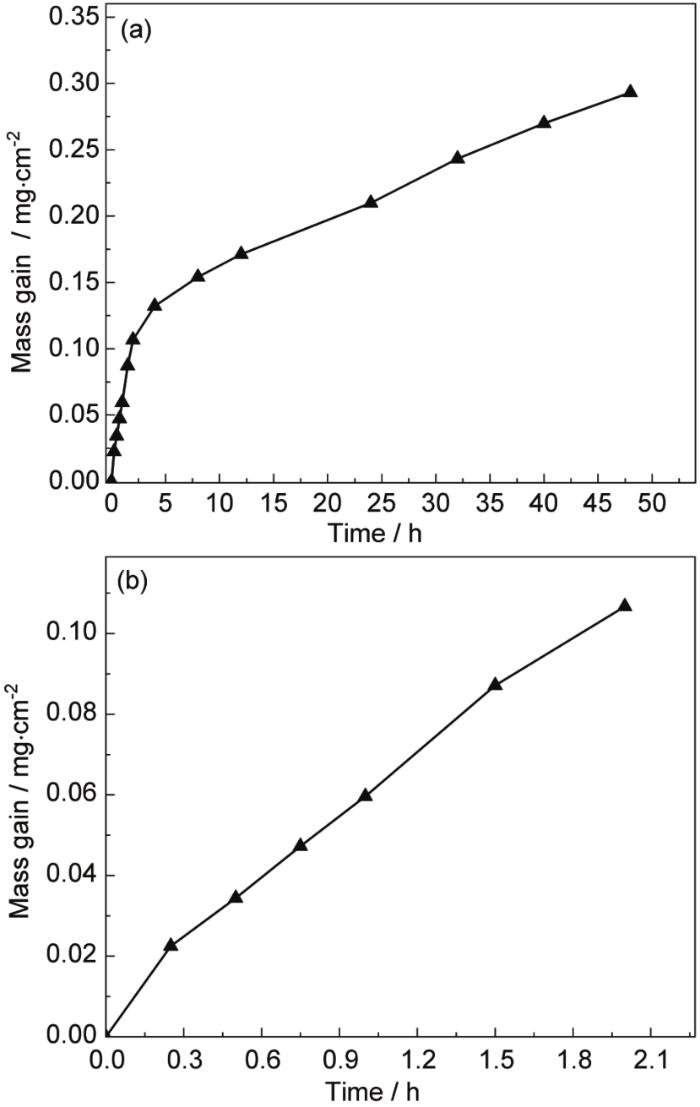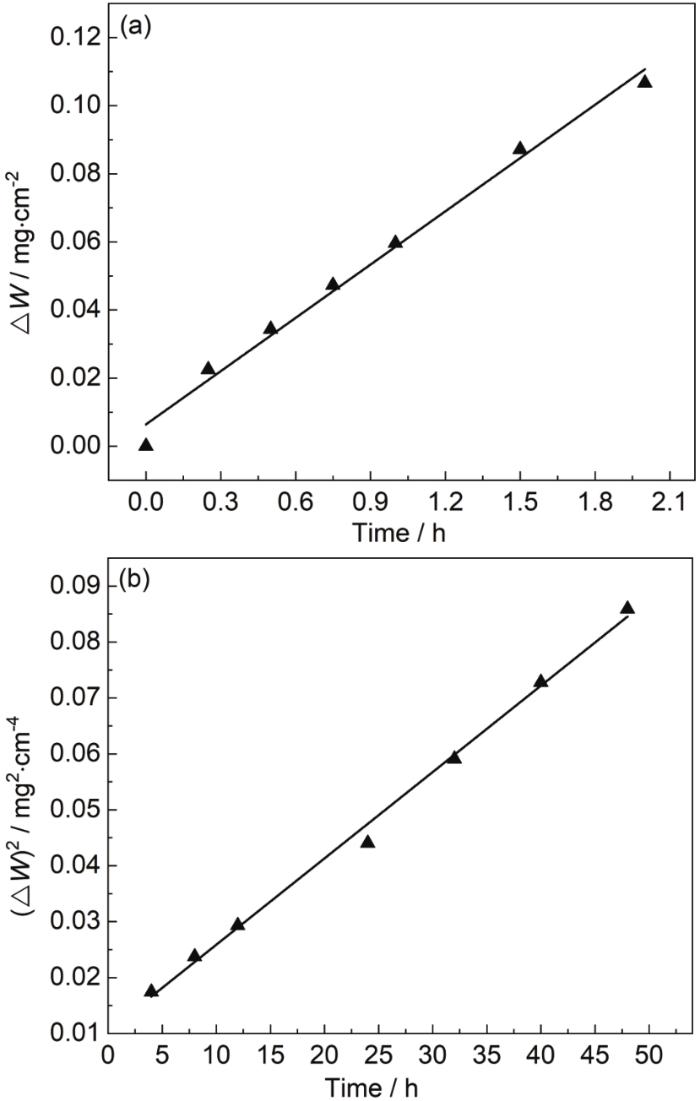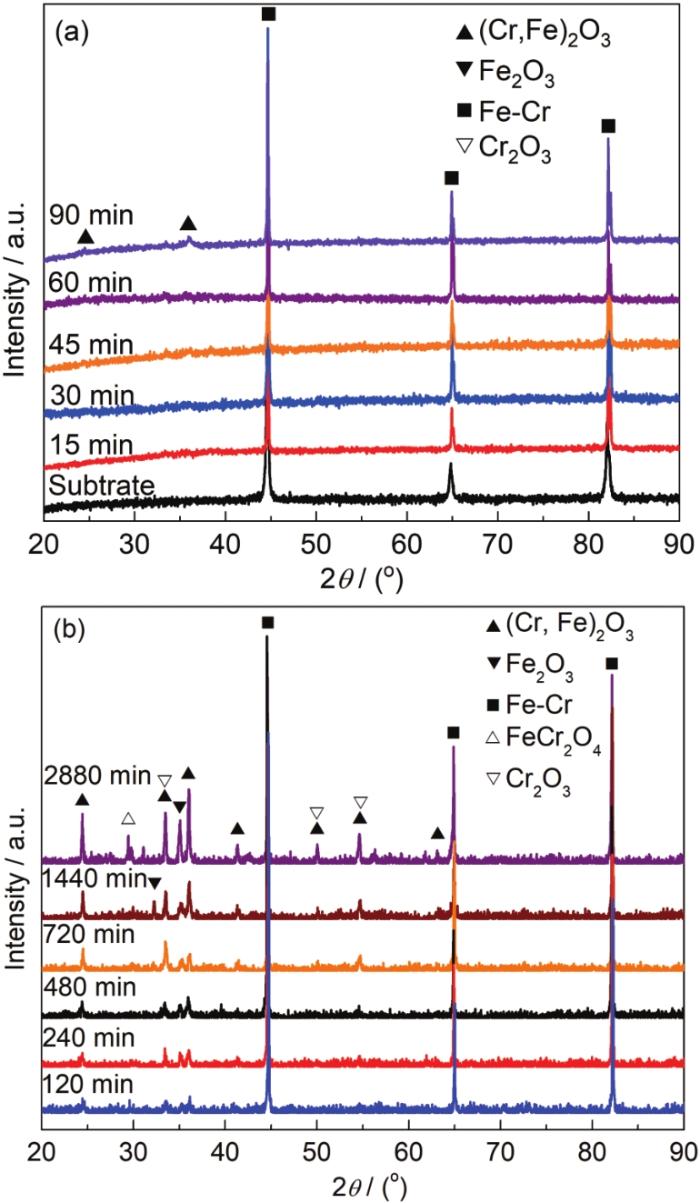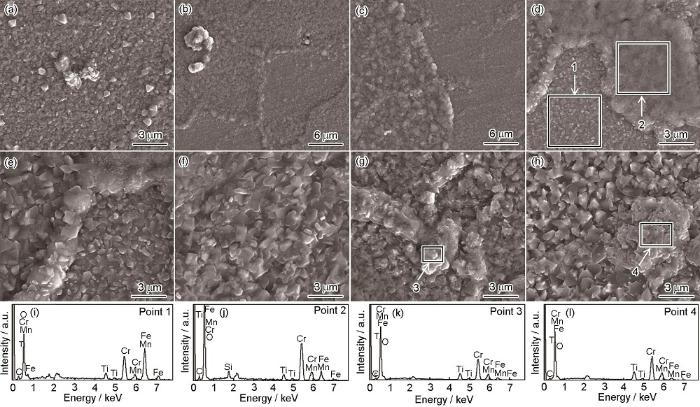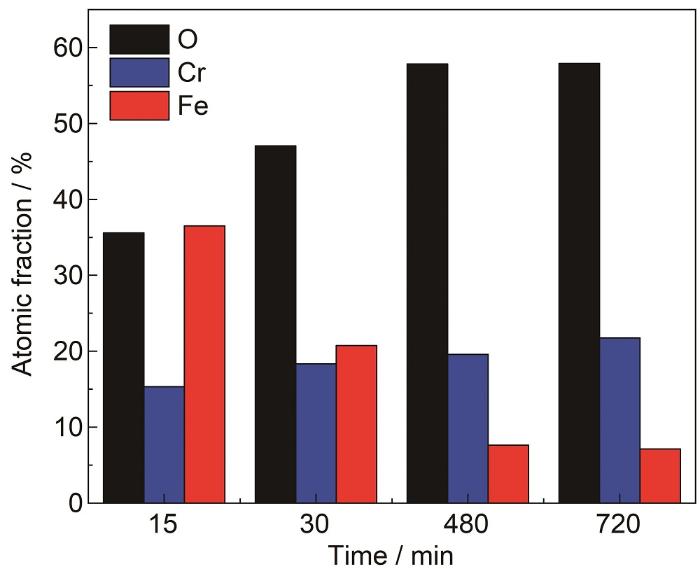核能发电具有高效、不排放温室气体等一系列优点[1,2]。高压加热器是核电站电机关键的辅助设备,服役环境苛刻[2-7],其稳定性和安全性对核电站的运行至关重要[8]。高压加热器故障会引起加热器管泄露会导致停机[9,10]。高压加热管在高温水蒸气中发生氧化,同时还承受包括水蒸气压力、温度梯度变化引起的热应力以及结构的几何约束力的作用[11-14],长期服役可能导致失效[15]。铁素体不锈钢的综合力学性能良好,抗晶间腐蚀性能优良、线膨胀系数小、导热系数高且经济耐用,核电机组中常选用TP439不锈钢作高压加热管材[16]。不锈钢在高温环境中抗氧化性与其表面生成的氧化膜的保护性密切相关。有研究[17]表明AISI439铁素体不锈钢在空气中的氧化动力学在850~950 ℃的长期氧化遵循抛物线规律。而TP439不锈钢在高温水蒸气中的初期氧化行为报道相对较少[18-20]。合金初期氧化形成的氧化膜对材料的后期氧化行为有重要影响,有助于进一步探明TP439不锈钢在高温水蒸气中的氧化规律。由于高压加热管所用的TP439不锈钢具有良好的抗氧化性能,在服役环境温度下短时间内难以观察到试样的氧化现象。目前,采用升高温度加速氧化,在较短时间内观察表面氧化膜的生成和演化规律是研究者通常采用的手段[20,21]。本文在800 ℃高温水蒸气环境中研究了TP439不锈钢不同阶段的氧化行为,分析了氧化物的形貌、结构和成分,简要探讨了TP439不锈钢在高温水蒸气中的氧化机理。
1 实验方法
实验材料为TP439铁素体不锈钢,其成分 (质量分数,%) 为:Cr 17.95,Ti 0.47,Mn 0.41,Ni 0.22,Cu 0.061,Mo 0.026,Al 0.007,Si 0.44,P 0.029,C 0.017,N 0.01,S 0.005,Fe余量。实验材料取自管材,经线切割后处理成尺寸为16 mm×15 mm×1.5 mm的矩形试样。将试样用400#、600#、800#、1200#、1500#、2000#砂纸进行逐级打磨,再使用抛光剂对其进行抛光处理,最后经丙酮清洗干净后用超纯水冲洗、吹干备用。
TP439不锈钢的高温水蒸气氧化实验在密封的管式气氛炉中进行,管式炉配置了一台水蒸气发生装置。将试样置于800 ℃高温水蒸气环境中进行加速氧化测试,气氛为90%H2O+10%Ar (体积分数,%)。测试时将试样置于立式气氛炉的恒温区,测试前先对管式炉通入纯Ar气以便排出炉内空气,快速升温至设定的氧化温度后,从管式炉下方充入90%H2O+10%Ar混合气氛,并保持气体流量为0.15 mm3/min。
试样在800 ℃高温水蒸气中进行氧化实验,分别氧化15、30、45、60、90、12、240、480、720、1440和2880 min,利用BT25S高精度天平对氧化后的样品称重,获得氧化动力学曲线。通过Nova Nano SEM450场发射电子扫描显微镜 (FE-SEM) 观察试样氧化后的表面形貌。采用INCA型能谱仪 (EDS) 及Bruker D8-Advance型X射线衍射仪 (XRD) 分析膜层的表面成分及相组成。
2 实验结果
2.1 氧化动力学
图1为TP439不锈钢试样在不同氧化时间的氧化动力学曲线。从图可见,样品氧化过程中持续增重,在0~120 min的初期氧化速度较快,随后氧化速率随着膜层的增厚而逐渐变缓。从氧化动力学的变化趋势可以看出,TP439不锈钢在初期快速氧化阶段和随后氧化阶段的氧化机理应该不同。
图1
图1
TP439不锈钢在800 ℃高温水蒸气中48和2 h的氧化动力学曲线
Fig.1
Oxidation kinetics of TP439 stainless steel in Ar-90%H2O at 800 ℃ for 48 h (a) and 2 h (b)
图2为TP439不锈钢在800 ℃高温水蒸气中的氧化动力学拟合结果。由拟合结果可知,TP439不锈钢氧化动力学曲线可分为两个不同阶段,在氧化初期阶段 (0~2 h) 的氧化动力学遵循线性规律,而在随后第二阶段遵循抛物线规律。拟合线性速率常数kl (mg/cm2·h) 和抛物线速率常数kp (mg2/cm4·h),其数学表达式如下:
其中,
图2
图2
TP439不锈钢在800 ℃高温水蒸气中的氧化动力学拟合结果
Fig.2
Fitting results of oxidation kinetics of TP439 stainless steel in Ar-90%H2O at 800 ℃ in the periods of 0-2 h (a) and 2-48 h (b)
2.2 氧化产物分析
图3为TP439不锈钢试样在800 ℃高温水蒸气环境中氧化不同时间后的XRD谱图。在氧化1.5 h之前,仅观察到Fe-Cr的衍射峰;在氧化1.5 h后,检测到一些微弱的 (Cr,Fe)2O3衍射峰;氧化2 h后,在试样表面检测到了Cr2O3和Fe2O3衍射峰,表明试样表面在初始氧化阶段主要形成富Cr氧化物。随着氧化时间的增加,样品表面的 (Cr,Fe)2O3、Fe2O3、Cr2O3、FeCr2O4的特征峰逐渐增强。从图3b可知,试样在氧化48 h后仍能检测到较强Fe-Cr相,说明试样表面生成的氧化膜仍较薄,表面氧化产物的主要成分为 (Cr,Fe)2O3和少量的Cr2O3、FeCr2O4、Fe2O3。
图3
图3
TP439不锈钢在800 ℃高温水蒸气中氧化不同时间后的XRD谱图
Fig.3
XRD patterns of TP439 stainless steel after isothermal oxidation at 800 ℃ for 0-1.5 h (a) and 2-48 h (b)
2.3 氧化形貌及能谱分析
图4
图4
TP439不锈钢在800 ℃高温水蒸气中氧化不同时间后的表面形貌及其对应的能谱图
Fig.4
Surface morphologies (a-h) and corresponding EDS results (i-l) of the samples oxidized at 800 ℃ for 15 min (a), 30 min (b), 45 min (c), 90 min (d), 120 min (e), 240 min (f), 480 min (g) and 720 min (h)
图5
图5
TP439不锈钢在800 ℃高温水蒸气中氧化不同时间后的表面形貌图
Fig.5
Surface morphologies of the samples oxidized at 800 ℃ for 15 min (a), 30 min (b), 480 min (c) and 720 min (d)
图6
图6
图5中O、Cr和Fe成分与氧化时间变化关系图
Fig.6
Contents of O, Cr and Fe after oxidation for different time
3 分析讨论
3.1 TP439不锈钢发生氧化的热力学判据
水蒸汽发生器和石英管中的混合气体的压力为一个大气压。氧气的分压可以通过以下公式计算得出[22]:
其中,ΔGº是标准自由能变化,T是热力学温度,kp是平衡常数,R是气体常数,p(H2),p(O2) 和p(H2O) 分别是氢气,氧气和水蒸气的分压。考虑到混合气体是流动的,可以假设氢的分压是氧的分压的两倍。根据饱和水蒸气压力与温度关系表[23],系统中水蒸气分压为9.09×104 Pa。在高温下,水蒸气可分解成氢和氧,在本系统环境中,T=800 ℃ (1073 K),可求出氧气的平衡分压为1.13×10-14 Pa。
TP439不锈钢在800 ℃高温水蒸气环境中氧化生成了Cr2O3和Fe2O3。通过反应式 (8) 和 (9) 可以由热力学计算出氧化物的平衡氧分压。
查热力学函数表[24]可知Cr2O3在800 ℃时的Gibbs自由能为-1269.45 kJ/mol,Fe2O3的Gibbs自由能为-1359.38 kJ/mol。求出Cr2O3和Fe2O3的平衡氧分压分别为:6.30×10-37 Pa和7.61×10-40 Pa,两者均低于环境中的氧分压,因此可以判定合金中的Cr和Fe在此温度条件下满足发生氧化的必要条件。
3.2 氧化动力学及氧化产物分析
3.3 TP439不锈钢在高温水蒸气中沿晶界快速氧化的过程
在氧化初期过程中,TP439表面生成了网状氧化物,为阐明网状氧化物的形成和演化过程,建立了TP439不锈钢在高温水蒸气中氧化物沿晶界氧化生长模型,如图7所示。
图7
图7
TP439不锈钢在高温水蒸气中氧化物沿晶界生长示意图
Fig.7
Schematic diagrams of the growth of oxides along the grain boundaries of TP439 stainless steel in high temperature water vapor: (a) oxides grow along bound aries, (b) netlike oxides, (c) neilike microstructure disappeared, (d) oxide film
在氧化初期,试样表面生成大量细小的氧化铁和氧化铬的氧化颗粒,由于金属离子沿晶界扩散快,沿晶界区域分布了较多的氧化颗粒,如图7a所示;随着氧化时长的增加,这些细小的氧化物颗粒 (图7a中分布的黑点) 进一步长大形成氧化薄膜覆盖于基体表面,晶界处由于是金属离子尤其是Cr扩散的快速通道,氧化物生长速度比其他区域生长速率更快[29,30],根据EDS分析结果,在样品表面形成了沿晶界生长“脊状”富铬氧化物,在低倍下沿晶界呈网状分布,其形貌如图7b所示;随着氧化时间延长,由于Cr沿晶界快速扩散,会导致晶界贫铬,同时晶界处氧化物增厚,金属离子沿晶界向外扩散阻力增加,非晶界处氧化物继续生长,氧化物沿晶界快速生长的特征逐渐消失,如图7c所示;由于氧化物沿晶界生长速度变慢,试样部分表面网状氧化物特征变得不明显,如图7d所示。图7a中均匀分布的氧化物随着氧化时间的延长逐渐增厚,突出的“脊状”氧化变得不明显,最后形成图7d形貌。
4 结论
(1) TP439不锈钢在初期阶段的氧化速率较快,氧化动力学符合线性氧化规律,线性速率常数kl为5.21×10-2 mg·cm-2·h-1;第二阶段的氧化动力学符合抛物线增长规律,抛物线速率常数kp为1.54×10-3 mg·cm-2·h-1。
(2) TP439不锈钢氧化2 h后,XRD检测到微弱的 (Cr,Fe)2O3、Cr2O3和Fe2O3衍射峰;氧化48 h后,氧化产物的主要成分为 (Cr,Fe)2O3和少量的Cr2O3、Fe2O3、FeCr2O4尖晶石氧化物。
(3) 在800 ℃高温水蒸气环境中,TP439不锈钢在氧化初期阶段,氧化过程受界面反应控制,随着氧化膜的不断增厚,离子在氧化膜中的扩散速度受到阻碍,氧化控制步骤转为扩散控制。由于晶界是元素快速扩散通道,在氧化过程中表面沿晶界处生成网状氧化物,但随氧化时间延长,网状氧化物特征变得不明显。
参考文献
Fatigue lifetime assessment on a high-pressure heater in supercritical coal-fired power plants during transient processes of operational flexibility regulation
[J].
Investigation of the flow characteristics in a main nuclear power plant pump with eccentric impeller
[J].
Application of 439 ferrite tube to feedwater heater
[J].
铁素体439焊管在给水加热器中的应用
[J].
Failure analysis on the O-ring of radial thrust bearing room of main pump in a nuclear power plant
[J].
Analysis on the larger drain subcooler approach of high pressure heater and its countermeasure
[J].
高压加热器疏水端差偏大原因分析及应对策略
[J].
R&D of the gas engine heat pump water heater and energy evaluation of the system
[A]. MatsumotoM, UmedaY, Masui, K, et al. Design for Innovative Value Towards a Sustainable Society [M].
Leakage of HP feedwater heater and preventive measures
[J].
高压加热器管子泄漏原因分析和防止措施
[J].
Effect of grain size on oxidation of heat-resistant steels in high temperature water steam
[J].
晶粒尺寸对耐热钢在高温水蒸汽中的氧化行为的影响
[J].
Modeling for the performance evaluation of 600 MW supercritical unit operating No.0 high pressure heater
[J].
Ion diffusion study in the oxide layers due to oxidation of AISI 439 ferritic stainless steel
[J].
Stress corrosion cracking failure of a SS 316L high pressure heater tube
[J].
SCC behavior of TP439 stainless steel in high temperature and high pressure water
[J].
TP439不锈钢在高温高压水中的应力腐蚀开裂行为
[J].
Cyclic oxidation behavior of Fe-9Cr-1Mo steel in water vapor atmosphere
[J].
Oxidation behavior of T91 steel in water vapor atmosphere at 750 ℃
[J].
Thermal analysis of closed feedwater heaters in nuclear power plants
[J].
Ferritic stainless steels in structural applications
[J].
Research on properties of SA803TP439 heat exchange tubes for high pressure heater in nuclear power plant
[J].
核电厂高压加热器SA803TP439换热管的性能研究
[J].
Evaluation on TP439 welded tube for high-pressure feedwater heater of nuclear power stations
[J].
核电站高压加热器用TP439焊管的评估
[J].
Application of TP439 welded pipe in high voltage heaters of domestic nuclear power plants
[J].
TP439焊管在国内核电站高压加热器的应用
[J].
Oxidation of AISI 304 and AISI 439 stainless steels
[J].
High temperature oxidation of the austenitic (35Fe27Cr31Ni) alloy sanicro 28 in O2+H2O environment
[J].
High temperature oxidation and corrosion of metals
[J].
Oxidation behaviour of sanicro 25 (42Fe22Cr25NiWCuNbN) in O2/H2O mixture at 600 ℃
[J].
Crack growth rate of stress corrosion cracking of Inconel 625 in high temperature steam
[J].
Inconel625合金在高温水蒸气环境中应力腐蚀开裂裂纹扩展速率研究
[J].
Temperature and water vapour effects on the cyclic oxidation behaviour of Fe-Cr alloys
[J].
Determination of oxygen diffusion coefficient in oxidation films of the AISI 439 ferritic stainless steel
[J].
A determination of the chromium concentration for 'healing' layer formation during the oxidation of chromium-depleted 20cr-25ni-nb stainless steel
[J].




